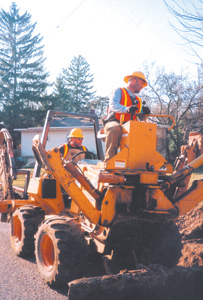FTTP (FIBER TO THE PREMISES)

Richard Gilbert, president of Gilbert Contractors explained that there were four major contractors that received the Verizon bid for the groundwork and the Gilbert Company is a sub-contractor of one of the four.
The new fiber optic cable is one of the most significant advancements in telecommunications technology in the past 100 years.
Known as fiber-to-the-premises, or FTTP, the fiber-optic network uses hair-thin strands of fiber and optical electronics to directly link homes and businesses. The new network replaces the traditional copper-wire connections and will unleash a range of advanced communication services.
Building the fiber-optic network locally will take more than two years, but it will completely transform communication services. Fort Wayne and New Haven are the company’s first FTTP markets in the Great Lakes region.
Verizon began building its FTTP network in parts of California, Delaware, Florida, Maryland, Massachusetts, New York, Pennsylvania, Texas and Virginia.
The fully fiber-optic network is technically superior to other communication platforms because it offers faster data speeds than those currently available, as well as, voice and video capabilities.
There will be three downstream speeds available; 5Mbps (megabits per second), 15 Mbps and 30 Mbps. Although the use of fiber optics is common for long-distance communications throughout the telecommunications industry, Verizon is one of the first major telecom companies to begin using it to directly connect homes and businesses to the network on a widespread scale.
Verizon expects to install more than 6.5 million feet of fiber-optic cabling in the Fort Wayne area, passing about 65,000 homes and small businesses with fiber. The company’s fiber cables and related equipment will be located inside the company’s local central switching offices, buried in the ground or placed on utility poles, using existing rights of way.
The FTTP initiative represents a natural extension of the more than 10 million miles of fiber-optic cable Verizon already has in place and extends the high capacity, speed and quality of fiber directly to the customer’s doorstep. When customers want more capacity, higher speeds or future video services, Verizon will be able to provide them instantly through the use of FTTP technology.
- What To Know About Mosquito Season - July 19, 2024
- Local Worship & Events: July 19 Update - July 19, 2024
- Allen County Bar Foundation Announces Scholarship Winners - July 19, 2024


